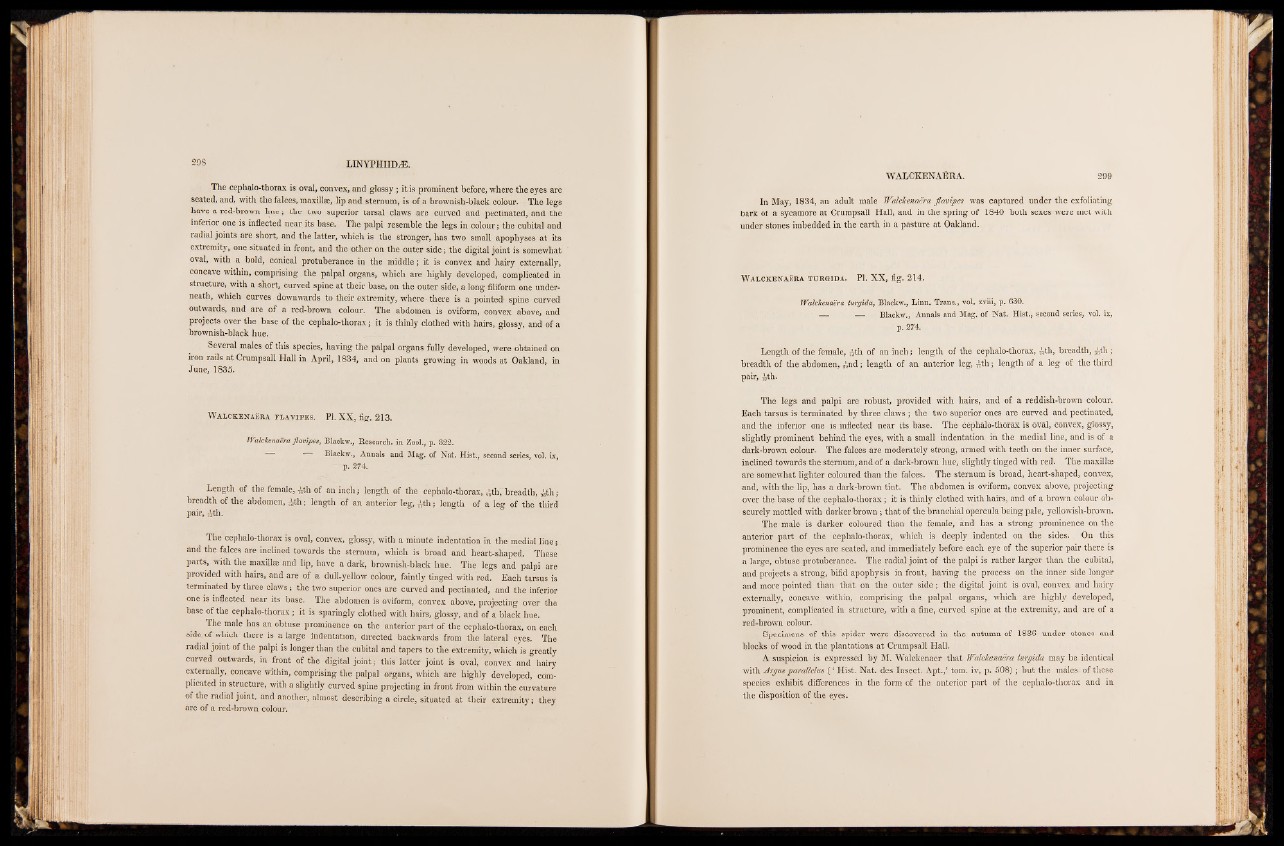
The cephalo-thorax is oval, convex, and glossy; it is prominent before, where the eyes are
seated, and, with the falces, maxillae, lip and sternum, is of a brownish-black colour. The legs
have a red-brown h u e ; the two superior tarsal claws are curved and pectinated, and the
inferior one is inflected near its base. The palpi resemble the legs in colour; the cubital and
radial joints are short, and the latter, which is the stronger, has two small apophyses at its
extremity, one situated in front, and the other on the outer side; the digital joint is somewhat
oval, with a bold, conical protuberance in the middle; it is convex and hairy externally,
concave within, comprising the palpal organs, which are highly developed, complicated in
structure, with a short, curved spine at their base, on the outer side, a long filiform one underneath,
which curves downwards to their extremity, where there is a pointed’ spine curved
outwards, and are of a red-brown colour. The abdomen is oviform, convex above, and
projects over the base of the cephalo-thorax; it is thinly clothed with hairs, glossy, and of a
brownish-black hue.
Several males of this species, having the palpal organs fully developed, were obtained on
iron rails at Crumpsall Hall in April, 1834, and on plants growing in woods at Oakland, in
June, 1835.
Walckenaera flavipes. PI. XX, fig. 213.
Walckenaera flavipes, Blackw., Research, in Zool., p. 322.
Blackw., Annals and Mag. of Nat. Hist., second series, vol. ix,
— p. 274.
Length of the female, ith of an inch; length of the cephalo-thorax, ^th; breadth, s'ath;
breadth of the abdomen, ^ th; length of an anterior leg, frth; length of a leg of the third
pair, Ath.
The cephalo-thorax is oval, convex, glossy, with a minute indentation in the medial lin e ;
and the falces are inclined towards the sternum, which is broad and heart-shaped. These
parts, with the maxillae and lip, have a dark, brownish-black hue. The legs and palpi are
provided with hairs, and are of a dull-yellow colour, faintly tinged with red. Each tarsus is
terminated by three claws; the two superior ones are curved and pectinated, and the inferior
one is inflected near its base. The abdomen is oviform, convex above, projecting over the
base of the cephalo-thorax; it is sparingly clothed with hairs, glossy, and of a black hue.
The male has an obtuse prominence on the anterior part of the cephalo-thorax, on each
side of which there is a large indentation, directed backwards from the lateral eyes. The
radial joint of the palpi is longer than the cubital and tapers to the extremity, which is greatly
curved outwards, in front of the digital joint; this latter joint is oval, convex and hairy
externally, concave within, comprising the palpal organs, which are highly developed, complicated
in structure, with a slightly curved spine projecting in front from within the curvature
of the radial joint, and another, almost describing a circle, situated at their extremity; they
are of a red-brown colour.
In May, 1834, an adult male Walckenaera fla vip es was captured under the exfoliating
bark of a sycamore at Crumpsall Hall, and in the spring of 1840 both sexes were met with
under stones imbedded in the earth in a pasture at Oakland.
Walckenaera turgida. PI. XX, fig. 214.
Walckenaera turgida, Blackw., Linn. Trans., vol. xviii, p. 630.
— :;;V4 Blackw., Annals and Mag. of Nat. Hist., second series, vol. ix,
p. 274.
Length of the female, -rath of an inch; length of the cephalo-thorax, ®jth, breadth, ^th ;
breadth of the abdomen, ^nd; length of an anterior leg, rrth; length of a leg of the third
pair, ^th.
The legs and palpi are robust, provided with hairs, and of a reddish-brown colour.
Each tarsus is terminated by three claws ; the two superior ones are curved and pectinated,
and the inferior one is inflected near its base. The cephalo-thorax is oval, convex, glossy,
slightly prominent behind the eyes, with a small indentation in the medial line, and is of a
dark-brown colour. The falces are moderately strong, armed with teeth on the inner surface,
inclined towards the sternum, and of a dark-brown hue, slightly tinged with red. The maxillae
are somewhat lighter coloured than the falces. The sternum is broad, heart-shaped, convex,
and, with the lip, has a dark-brown tint. The abdomen is oviform, convex above, projecting
over the base of the cephalo-thorax; it is thinly clothed with hairs, and of a brown colour obscurely
mottled with darker brown; that of the branchial opercula being pale, yellowish-brown.
The male is darker coloured than the female, and has a strong prominence on the
anterior part of the cephalo-thorax, which is deeply indented on the sides. On this
prominence the eyes are seated, and immediately before each eye of the superior pair there is
a large, obtuse protuberance; The radial joint of the palpi is rather larger than the cubital,
and projects a strong, bifid apophysis in front, having the process on the inner side longer
and more pointed than that on the outer sid e ; the digital joint is oval, convex and hairy
externally, concave within, comprising the palpal organs, which are highly developed,
prominent, complicated in structure, with a fine, curved spine at the extremity, and are of a
red-brown colour.
Specimens of this spider were discovered in the autumn of 1836 under stones and
blocks of wood in the plantations at Crumpsall Hall.
A suspicion is expressed by M. Walckenaer that Walckenaera turgida may be identical
with A rgusparallelus ( ‘ Hist. Nat. des Insect. Ap t./ tom. iv, p. 508); but the males: of these
species exhibit differences in the form of the anterior part of the cephalo-thorax and in
the disposition of the eyes.